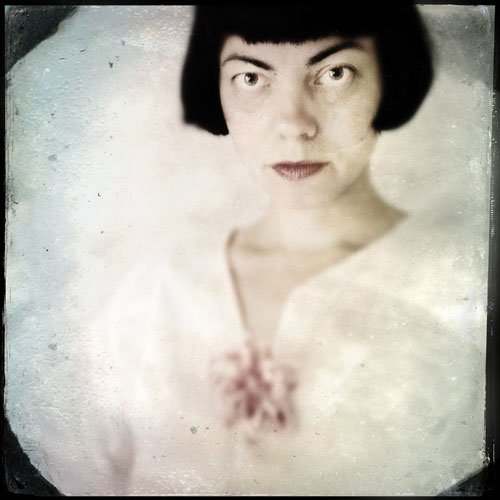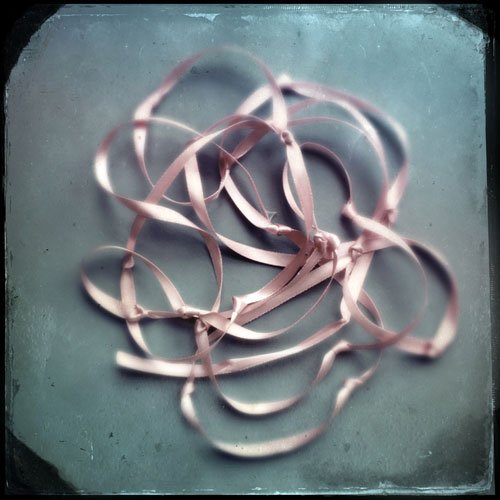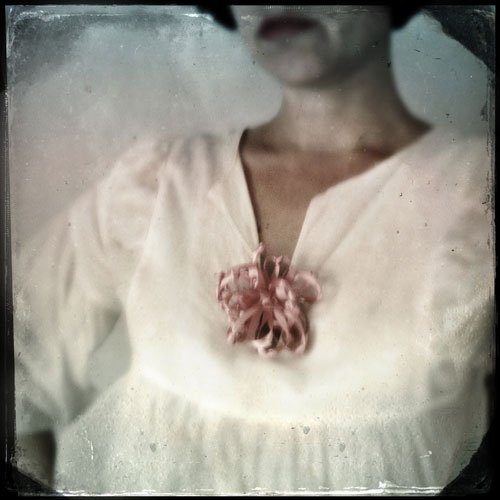A Beautiful Soul
 Only very recently did I discover the ethereal work of Scottish photographer Lady Clementina Hawarden (1822–1865), via an Instagram page called VictorianDarlings.
Only very recently did I discover the ethereal work of Scottish photographer Lady Clementina Hawarden (1822–1865), via an Instagram page called VictorianDarlings.
For a moment they took my breath away, for there was something achingly poignant and tender about them: the soft natural light that gently bathed these young women and diffused into grand interiors, this glimpse of a woman’s exploration of her subject – her daughters, mostly – in the pioneering days of photography.

 Produced by albumen prints from wet-collodian negatives, the most popular method in the mid 19th century, Hawarden’s photographs are like paintings, sumptuous and delicate at the same time.
Produced by albumen prints from wet-collodian negatives, the most popular method in the mid 19th century, Hawarden’s photographs are like paintings, sumptuous and delicate at the same time.
Hawarden called her work ‘studies’, and she worked in natural light, unlike many of her contemporaries, using mirrors to distribute the light pouring into her interiors through huge windows or French doors. In largely empty rooms, she used props, mirrors, draped fabric and curtains, and clothing made up of both contemporary and costume dress to create exquisite portraits, and tableaux (a popular theme of the era) of her daughters.
Windows, an obvious and convenient source of light, become a framing device, and offer a glimpse of the balcony beyond; further off, the city becomes a blurred background.

 Most of what is known about Hawarden must be gleaned from her work; some art critics have made suppositions about her themes, for instance, exploring sexuality and adolescence, subjects that bothered the Victorians; but that can only be guesswork, and dubious at that when viewed through a contemporary lens (no pun intended). She left no diaries, nor was there any accompanying archival material when the photographs were generously donated to the V&A Museum by her granddaughter in 1939. They were cut or torn from family albums – there is no explanation as to why, but my guess is stubborn glue! (Sometimes the simplest answer is the right one.)
Most of what is known about Hawarden must be gleaned from her work; some art critics have made suppositions about her themes, for instance, exploring sexuality and adolescence, subjects that bothered the Victorians; but that can only be guesswork, and dubious at that when viewed through a contemporary lens (no pun intended). She left no diaries, nor was there any accompanying archival material when the photographs were generously donated to the V&A Museum by her granddaughter in 1939. They were cut or torn from family albums – there is no explanation as to why, but my guess is stubborn glue! (Sometimes the simplest answer is the right one.)

 I think Hawarden found a creative outlet that thrilled her – she produced her entire oeuvre (over 800 photographs) by painstaking method in only approximately seven years – and in an era when this art form was so new, above all she wanted to make beautiful pictures. Is that not enough without casting about for bogeymen? To me, the photographs speak for themselves – and of her beautiful soul.
I think Hawarden found a creative outlet that thrilled her – she produced her entire oeuvre (over 800 photographs) by painstaking method in only approximately seven years – and in an era when this art form was so new, above all she wanted to make beautiful pictures. Is that not enough without casting about for bogeymen? To me, the photographs speak for themselves – and of her beautiful soul.
Read more about Lady Clementina Hawarden and see more of her work at V&A Museum.



Images from V&A Museum, and Pinterest.
Captivating Style
 On the weekend while visiting the Ian Potter Centre at Federation Square, I wandered through the fashion exhibition Captivating Style, 1950s Melbourne for a second time. It celebrates the work of Melbourne fashion designer Hall Ludlow, milliner Thomas Harrison and photographer Athol Shmith.
On the weekend while visiting the Ian Potter Centre at Federation Square, I wandered through the fashion exhibition Captivating Style, 1950s Melbourne for a second time. It celebrates the work of Melbourne fashion designer Hall Ludlow, milliner Thomas Harrison and photographer Athol Shmith.
Although the exhibition is very small (it would be amazing if it was three times the size at least), it is still full of some exquisite examples of mid twentieth century fashion.
 Hats by Thomis Harrison
Hats by Thomis Harrison Turban of draped and stitched sisal, trimmed with cubes of wood; by Thomas HarrisonThomas Harrison (1897–81) established his own millinery house in Collins St, Melbourne in 1929, and it operated until 1981 – a magnificent length of time by anyone’s standards. His salon was decorated with eighteenth-century furniture, an opulent setting for showing two seasonal collections a year. In addition, Harrison created bespoke hats for regular clients.
Turban of draped and stitched sisal, trimmed with cubes of wood; by Thomas HarrisonThomas Harrison (1897–81) established his own millinery house in Collins St, Melbourne in 1929, and it operated until 1981 – a magnificent length of time by anyone’s standards. His salon was decorated with eighteenth-century furniture, an opulent setting for showing two seasonal collections a year. In addition, Harrison created bespoke hats for regular clients.
 Hall Ludlow’s stunning coat with architctural lines is made of wool, acetate and plastic Hall Ludlow immigrated to Australia in 1947 from New Zealand, and, like Harrison, opened a boutique on Collins St. It was also similarly and lavishly furnished with satin drapes, gilded mirrors, golden cherubs and chandeliers. The consummate couturier, Ludlow handled everything, from fabric selection to finishing, often working without patterns as he cut his avant-garde designs.
Hall Ludlow’s stunning coat with architctural lines is made of wool, acetate and plastic Hall Ludlow immigrated to Australia in 1947 from New Zealand, and, like Harrison, opened a boutique on Collins St. It was also similarly and lavishly furnished with satin drapes, gilded mirrors, golden cherubs and chandeliers. The consummate couturier, Ludlow handled everything, from fabric selection to finishing, often working without patterns as he cut his avant-garde designs.
 This lustrous gown makes a feature of the décolletage with a high-standing collar and v-shaped neckline framed by fine rows of parallel stitching, one of Ludlow’s signaturesThe four garments shown were donated to the National Gallery of Victoria by Peggy Stone, who was a longstanding client and friend of the designer. She commissioned him to create numerous special occasion dresses that she wore to business conferences and balls she attended with her husband.
This lustrous gown makes a feature of the décolletage with a high-standing collar and v-shaped neckline framed by fine rows of parallel stitching, one of Ludlow’s signaturesThe four garments shown were donated to the National Gallery of Victoria by Peggy Stone, who was a longstanding client and friend of the designer. She commissioned him to create numerous special occasion dresses that she wore to business conferences and balls she attended with her husband.
 Leah McCartney, c 1954, by Athol Shmith
Leah McCartney, c 1954, by Athol Shmith Beauty, 1950s, by Athol ShmithAthol Shmith was a celebrated fashion photographer whose career spanned more than fifty years. He began to photograph in the early 1930s, working from a studio in St Kilda before he two moved to the ‘Paris End’ of town in Collins St. Adopting European trends of clean lines, sharp angles and dramatic lighting, his work became synonymous with sophisticated and modern glamour.
Beauty, 1950s, by Athol ShmithAthol Shmith was a celebrated fashion photographer whose career spanned more than fifty years. He began to photograph in the early 1930s, working from a studio in St Kilda before he two moved to the ‘Paris End’ of town in Collins St. Adopting European trends of clean lines, sharp angles and dramatic lighting, his work became synonymous with sophisticated and modern glamour.
 Model Virginia Grey, 1951, by Athol ShmithCurrently showing at NGV Australia in the Ian Potter Centre. Visit the exhibition and add a touch of vintage elegance to your day. Open 10am–5pm, Tue-Sun; entry is free.
Model Virginia Grey, 1951, by Athol ShmithCurrently showing at NGV Australia in the Ian Potter Centre. Visit the exhibition and add a touch of vintage elegance to your day. Open 10am–5pm, Tue-Sun; entry is free.
My Mexican Friend
 De las Manos, Yunuen Pérez and Sissy M. Reyes, 2012During the past month I designed a twelve-page catalogue for an exhibition my friend Yunuen Pérez and her creative partner Sissy M. Reyes are launching in May. What a delight it was to work with such gorgeous and colourful imagery, and with clients who were decisive, prompt to supply material and pleasant from beginning to end*!
De las Manos, Yunuen Pérez and Sissy M. Reyes, 2012During the past month I designed a twelve-page catalogue for an exhibition my friend Yunuen Pérez and her creative partner Sissy M. Reyes are launching in May. What a delight it was to work with such gorgeous and colourful imagery, and with clients who were decisive, prompt to supply material and pleasant from beginning to end*!
But more importantly, the photographic exhibition is called Mex-tli, Mexican Goddesses, and reflects the pair’s respective artistic practices, with an emphasis on cross-cultural aesthetics and the power of the image.
Yunuen is a costume and production designer for theatre and multimedia, and Sissy a cinematographer and producer in a variety of independent and commercial film and media projects. A couple of years ago they decided they would combine their creative talents. They embarked on a venture exploring their experiences as Mexican immigrants in Australia, a journey that would combine two very different cultures and discover where similarity diverged and came together again.
 Jaguar’s Roar, Yunuen Pérez and Sissy M. Reyes, 2012The pair focus on Mexican indigenous women: their stories; their roles in society and legend; and the traditional costumes they wear. Depictions of ancient ceremony and modern rituals reveal meanings as layered as the highly patterned, embroidered textiles they don for these twelve self-portraits. There is a grandeur in the formal, highly constructed mise-en-scène, a glimpse of another world, another experience – and a wealth of fascinating detail. It’s a chance to open one’s eyes.
Jaguar’s Roar, Yunuen Pérez and Sissy M. Reyes, 2012The pair focus on Mexican indigenous women: their stories; their roles in society and legend; and the traditional costumes they wear. Depictions of ancient ceremony and modern rituals reveal meanings as layered as the highly patterned, embroidered textiles they don for these twelve self-portraits. There is a grandeur in the formal, highly constructed mise-en-scène, a glimpse of another world, another experience – and a wealth of fascinating detail. It’s a chance to open one’s eyes.
The exhibition is showing from 7–18 May at fortyfivedownstairs, 45 Flinders Lane, Melbourne 3000.
*No designer sensibilities were harmed during the creation of this piece of graphic design.
Love Knots
 Boutonnière :: Tinto 1848 // C-Type Plate // No flash
Boutonnière :: Tinto 1848 // C-Type Plate // No flash Vintage 1920s lingerie pin from Beautiful ReignI often make jokes about ‘researching’ stories on Etsy as opposed to merely wasting time window-shopping, but on the odd occasion it’s true. One discovery in the store Beautiful Reign while on a search on 1920s boudoir caps led to some craft-making. I thought these ribbon flowers were very pretty, but never bought them. After they were sold, I decided I could very likely make my own.
Vintage 1920s lingerie pin from Beautiful ReignI often make jokes about ‘researching’ stories on Etsy as opposed to merely wasting time window-shopping, but on the odd occasion it’s true. One discovery in the store Beautiful Reign while on a search on 1920s boudoir caps led to some craft-making. I thought these ribbon flowers were very pretty, but never bought them. After they were sold, I decided I could very likely make my own.
 You’re A Peach :: Tinto 1848 // C-Type Plate // No flashIt’s not so easy to find modern ribbon made from silk, or even rayon, and I decided to use inexpensive polyester for my prototype. I purchased 2 metres of 6mm ribbon in a peachy colour, a typical 1920s lingerie shade.
You’re A Peach :: Tinto 1848 // C-Type Plate // No flashIt’s not so easy to find modern ribbon made from silk, or even rayon, and I decided to use inexpensive polyester for my prototype. I purchased 2 metres of 6mm ribbon in a peachy colour, a typical 1920s lingerie shade.
 Love Knots :: Tinto 1848 // C-Type Plate // No flashBy carefully examining the originals, I determined a method to simulate them. They were 2¼ inch in diameter, so I estimated one knot about every 10cm would suffice. These knots, by the way, I discovered were referred to as ‘love knots’. Experimenting with the size of the loops, I saw that I would need to use the entire 2m on one flower, not two as I’d originally supposed.
Love Knots :: Tinto 1848 // C-Type Plate // No flashBy carefully examining the originals, I determined a method to simulate them. They were 2¼ inch in diameter, so I estimated one knot about every 10cm would suffice. These knots, by the way, I discovered were referred to as ‘love knots’. Experimenting with the size of the loops, I saw that I would need to use the entire 2m on one flower, not two as I’d originally supposed.
 Sew Easy :: Tinto 1848 // C-Type Plate // No flashOnce I had finished tying fairly loose knots along the entire length (leaving about 15cm untied at each end just in case I should require it), I began forming and sewing the loops together. (Don’t use a rusty needle as I did!)
Sew Easy :: Tinto 1848 // C-Type Plate // No flashOnce I had finished tying fairly loose knots along the entire length (leaving about 15cm untied at each end just in case I should require it), I began forming and sewing the loops together. (Don’t use a rusty needle as I did!)
 All Tied Up :: Tinto 1848 // C-Type Plate // No flashThe flower was completed with a last knot over the middle to hide the stitches.
All Tied Up :: Tinto 1848 // C-Type Plate // No flashThe flower was completed with a last knot over the middle to hide the stitches.
 Pinned :: Tinto 1848 // C-Type Plate // No flashAmongst my supplies I already had a couple of spare brooch pins, and using the extra ribbon from each end, I attached the flower to the pin and wrapped ribbon around the base. It’s a much nicer finish than the original 1920s versions, if I do say so myself. Some flapper had lazily stitched the flowers to safety pins.
Pinned :: Tinto 1848 // C-Type Plate // No flashAmongst my supplies I already had a couple of spare brooch pins, and using the extra ribbon from each end, I attached the flower to the pin and wrapped ribbon around the base. It’s a much nicer finish than the original 1920s versions, if I do say so myself. Some flapper had lazily stitched the flowers to safety pins.
 Be Flowered :: Tinto 1848 // C-Type Plate // No flashMy flower ended up a little bigger, about 10cm or 3” across, but I think they are not too shabby for a first attempt. Certainly a natural fibre ribbon would sit, and feel, much nicer too.
Be Flowered :: Tinto 1848 // C-Type Plate // No flashMy flower ended up a little bigger, about 10cm or 3” across, but I think they are not too shabby for a first attempt. Certainly a natural fibre ribbon would sit, and feel, much nicer too.
Right, back to Etsy for some legitimate late-night shopping for vintage ribbon …
A Fashionable Hallowe’en

 OH! How much do I adore these vintage 1920s Hallowe’en costumes? So many of my favourite stripes and pompoms are featured. The designs are rather interesting with their Oriental flavour too – Chinoiserie was popular during the Art Deco period. I find them so much more interesting than modern costumes, which tend to be a bit garish for my taste. Amazingly, these 1920s costumes were intended to be made from crepe paper.
OH! How much do I adore these vintage 1920s Hallowe’en costumes? So many of my favourite stripes and pompoms are featured. The designs are rather interesting with their Oriental flavour too – Chinoiserie was popular during the Art Deco period. I find them so much more interesting than modern costumes, which tend to be a bit garish for my taste. Amazingly, these 1920s costumes were intended to be made from crepe paper.
The illustrations, by Barbara Crews, are pretty delicious too. Now here is a party I would love to go to.
Illustrations found via RetroGypsy.




